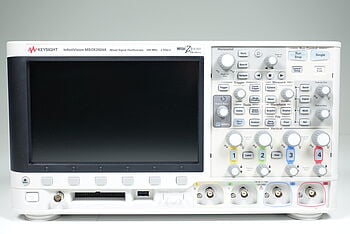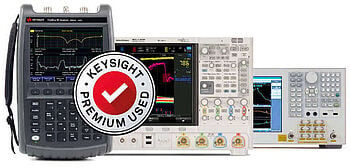Keysight Oscilloscope Glossary
What is a Composite Video Signal?
Many electronic engineers and enthusiasts might be surprised to discover that the composite video signal still holds relevance today. Despite the increase of high-definition, digital video interfaces, the understanding of composite video signals remains essential, especially when troubleshooting or designing video equipment.
This article takes an in-depth look at what composite video signals are, how they're used in oscilloscopes, and why they're still important.
The composite video signal was introduced during the era of analog television broadcasts. As its name suggests, it is a "composite" of various components necessary for television to function:
The composite signal is transmitted over a single line, hence the term 'composite.' It's a unique piece of technological history that set the stage for modern digital interfaces.
| Key Takeaway |
|---|
| Understanding composite video signals is essential for effectively troubleshooting video equipment. This involves understanding the components of the signal (luminance, chrominance, and synchronization pulses) and how they are displayed on an oscilloscope. |
A composite video signal contains three basic elements:
In any video system, the composite video signal plays an essential role in transmitting the video information from the source to the display device. The composite video signal is characterized by its specific structure, designed to convey visual data accurately and reliably. Let's dive deeper into its composition.
Each video line starts with an 8.3μs long video information field that contains the actual visual data. This data, corresponding to the brightness and color of each pixel on a single line of the display, is represented as modulations in the signal's amplitude.
Immediately following the video information field is a brief, approximately 0.2μs long, horizontal sync pulse. This pulse is crucial because it tells the display when to start drawing a new line.
After this pulse, the display device returns from the right end of the screen back to the left and commences displaying the next line. This cycle continues, one line after the next, building the visible image from left to right, top to bottom.
The pattern of video information followed by a horizontal sync pulse repeats around 525 times to form a single frame of video data. The specific number, 525, is a relic from the era of analog NTSC television and represents the total number of horizontal lines in the video frame. Modern digital systems may use other numbers, like 480, 720, or 1080, to denote the line count, but the principle remains the same.
After the series of line information is sent, a longer vertical sync pulse occurs. This pulse signifies the end of one full frame and the beginning of another. It tells the display that it should return from the bottom of the screen back to the top and start a new frame.
Video information is transmitted in frames, consisting of lines of video followed by horizontal and vertical sync pulses. This process is repeated at a rate of 30 times per second (or 60 fields per second in an interlaced system). This rate, also known as the refresh rate or frame rate, determines how smooth the motion appears on the screen.

Composite video signals can be challenging to understand without the help of an oscilloscope. When a composite video signal is connected to an oscilloscope, the different components of the signal can be visualized and separated for analysis. The three essential components are or an oscilloscope are as follows.
The luminance signal, often denoted as 'Y,' is responsible for conveying the brightness information of the video. The amplitude of this signal varies corresponding to the brightness of the video signal at that particular point.
An oscilloscope shows this component as a waveform varying between the blanking level (associated with the black level of the image) and peak white level (corresponding to the maximum brightness). Higher amplitudes correspond to brighter parts of the image, while lower amplitudes correspond to darker areas.
The separation of the luminance signal from the rest of the composite video signal can be achieved by removing the color burst, which essentially results in a black-and-white representation of the video content. Understanding this signal is crucial for adjusting the contrast and brightness in video devices.
The chrominance signal, or 'C,' provides the color information for the video signal. It's transmitted as a high-frequency burst immediately after the horizontal sync pulse, known as the color burst. This color burst sets the color reference for the upcoming line of video, establishing the 'zero color' point.
In an oscilloscope, the color burst appears as a regular pattern of waves following the sync pulse but before the start of active video. It has a specific frequency (3.579545 MHz in NTSC), and its phase and amplitude represent the hue and saturation of the color, respectively.
Understanding the chrominance signal is essential when working with color balance or diagnosing color issues in video devices.
Sync pulses are an essential part of the composite video signal, responsible for the synchronization of the video display. They ensure the electron beam (or pixels in digital systems) is in the correct position at the start of each line (horizontal sync) and each frame (vertical sync).
On an oscilloscope, sync pulses are identifiable as the signal's lowest points. They drop below the blanking level, which is why they stand out clearly on the oscilloscope. The horizontal sync pulse is a single low spike at the end of each line, while the vertical sync pulse is a longer sequence of low spikes that shows the end of one frame and the start of the next.
Proper synchronization is vital for the correct and stable display of video content. A malfunctioning sync signal could lead to several issues, such as rolling or tearing of the video image, making the understanding of these pulses critical for anyone working with video systems.
When troubleshooting video equipment, an oscilloscope is an indispensable tool, providing a detailed visual representation of composite video signals. The various distortions and issues that can affect video signals translate into specific patterns or anomalies on the oscilloscope's display.
Here is a table outlining some common issues and what they might look like on an oscilloscope.
| Issue | Cause | Visual Representation on Oscilloscope |
|---|---|---|
| Poor Contrast | Degraded luminance signal | The amplitude of the luminance waveform does not fully reach the expected peak white and blanking levels. The waveform may appear 'compressed,' lacking the full range of amplitudes. |
| Incorrect Color Representation | Distorted chrominance signal | The color burst following the sync pulse may be absent, irregular, or have incorrect frequency, phase, or amplitude. |
| Rolling Image | Incorrect vertical sync pulse | The vertical sync pulses may not be clearly visible or may occur at irregular intervals, causing a lack of stable synchronization for the frame. |
| Tearing Image | Incorrect horizontal sync pulse | The horizontal sync pulses may be distorted or absent, resulting in improper line synchronization. |
| Generalized Noise | Poor signal quality | The entire waveform appears 'fuzzy' or unstable, with irregularities throughout. This can lead to a range of image quality issues. |
Engineers can use an oscilloscope to pinpoint the source of the problem and apply appropriate fixes, whether it's filtering out noise, enhancing signal quality, or adjusting synchronization pulses. The ability to visualize these signals in real-time significantly enhances troubleshooting capabilities and makes it possible to address and rectify video issues more effectively.
In the fascinating world of electronic engineering, a profound understanding of composite video signals is a vital skill, relevant even in the age of digital video. Despite their historical origins, these signals form the foundation of many video technologies used today.
They are composed of three primary components:
As you continue exploring the realm of video signals, having the right tools at your disposal is crucial. If you're looking for the best tools available, be sure to check out Keysight's Used Equipment Store.
Whether you're looking for an oscilloscope to decode video signals or looking for other high-quality testing equipment like signal analyzers and network analyzers, Keysight has you covered. Harness the power of Keysight equipment to transform your technical know-how into tangible solutions today.
